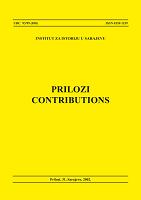Prve vijesti o pojavi hereze u Bosni
Appearance of Heresis in Bosnia (First Sources on the Appearance of Heresy in Bosnia)
Author(s): Elma HasimbegovicSubject(s): History
Published by: Institut za istoriju
Keywords: Heresy; Christianity; dualism; heresy
Summary/Abstract: Towards the end of XII and the beginning of XIII century there were allegations and complaints regarding the heresy in Bosnia. Original material in the period from 1199, when first accusations against Bosnian rulers arrived, until the moment of signing the abjuration, in 1203, was subjected to detailed analysis in this paper. Considerations took into account the sources relating the information provided to the Pope Innocent iii and Hungarian King Emerich on the problem of heresy in Bosnia, to the accusation that arrived from the Vukan, the ruler of Duklja and the Archbishop of Split, Bernard, the actions undertaken by Rome against the heretics in Bosnia and the investigation of the whole case. Original material encompasses, therefore, the correspondence of the Pope Innocent III with the Church and secular rulers of the period, such as: the letter by Vukan, the ruler of Duklja to the Pope in 1199, Pope’s invitation to the Hungarian King Emerich, dated 21st October 1200, the Popes invitation to the Archbishop of Split Bernard and to his chaplain Ivan de Casamaris, dated November 1202. The consideration covers another original document that dates from that time. It is the Kulin Ban’s Church, i.e., the inscription on the church in Muhašinovići near Visoko that was built by the Ban of Bosnia. This is the only source that originates from Bosnia and it is the only one that relates to the religious circumstances during the rule of Kulin Ban. Original material offers the information that is important for determining the date of the emergence of heresy, and gives foundations for the assumption relating its origins. One can not speak about more details relating the “heresy” itself, since the material comes from the papal office and is written in the typical idiom of this office, that refers to heretics, Patharens and Cathars while not necessarily implying any of these movements. Furthermore, based on the original material, one may pose the question of the motives of those w
Journal: Prilozi
- Issue Year: 2003
- Issue No: 32
- Page Range: 39-47
- Page Count: 9
- Language: Bosnian

